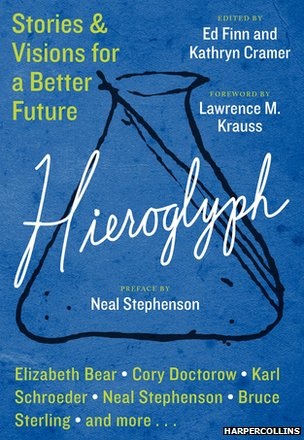Project Hieroglyph Aims To Combat Sci-Fi’s Obsession With Dystopian Bummers
This article is more than 2 years old
 There’s no doubt about it: dystopias are in. From modern works such as The Giver and The Hunger Games to older works such as 1984 and Brave New World, science fiction and the audiences that read and watch these products have been consumed by futuristic dystopian scenarios, especially as real life points to some of those scenarios as prophetic. Even though it’s undeniable that some of the genre’s warnings about the future have been on point, some writers think that sci-fi has become too focused on this area. Science fiction paves the way for the future, both in terms of the development and use of technologies and the way society views those technologies and their implications, so it makes sense that a dark vision of the future would ultimately have some kind of impact on humanity’s subconscious. Hence, Project Hieroglyph was born, and it aims to present “stories and visions for a better future.”
There’s no doubt about it: dystopias are in. From modern works such as The Giver and The Hunger Games to older works such as 1984 and Brave New World, science fiction and the audiences that read and watch these products have been consumed by futuristic dystopian scenarios, especially as real life points to some of those scenarios as prophetic. Even though it’s undeniable that some of the genre’s warnings about the future have been on point, some writers think that sci-fi has become too focused on this area. Science fiction paves the way for the future, both in terms of the development and use of technologies and the way society views those technologies and their implications, so it makes sense that a dark vision of the future would ultimately have some kind of impact on humanity’s subconscious. Hence, Project Hieroglyph was born, and it aims to present “stories and visions for a better future.”
Writers Neal Stephenson, Cory Doctorow, Elizabeth Bear, and others worked with actual scientists to brainstorm ideas that have a sense of “techno-optimism.” Since scientists and sci-fi writers have a symbiotic relationship, the idea behind Project Hieroglyph involves more than just happily ever after endings (which, let’s face it, would be pretty boring to read). The collection, which will be released on September 9 and is now available for pre-order, contains sci-fi stories grounded in science and featuring technologies that are or will be within humanity’s reach in the next 50 years. “A good science fiction story can be very powerful. It can inspire hundreds, thousands, millions of people to rally around something that they want to do,” says project director Ed Finn.
The book tackles topics such as environmental degradation, renewable energy, space exploration and colonization, and drone use. The writers got to essentially choose the technologies that appealed most to them—Neal Stephenson, for example, was really into the idea of a huge steel tower that extends beyond Earth’s atmosphere. Project Hieroglyph includes illustrations of some of these inventions, and the project also at some point involved 3D models of many of these technologies.
It’ll be interesting to see how these stories hold up to the ones that have made such an impression on readers and viewers. Will these readers be able to make these stories seem believable, rather than forcing optimism and positive outcomes onto the page? And ultimately, will readers have a changed—and more positive—view of the future by what they see here? Time will tell, and so, apparently, will science fiction.












